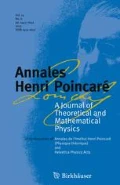Abstract
Consider a finite triangulation of a surface M of genus g and assume that spin-less fermions populate the edges of the triangulation. The quantum dynamics of such particles takes place inside the algebra of canonical anti-commutation relations (CAR). Following Kitaev’s work on toric models, we identify a sub-algebra of CAR generated by elements associated to the triangles and vertices of the triangulation. We show that any Hamiltonian drawn from this sub-algebra displays topological spectral degeneracy. More precisely, if \({{\mathcal {P}}}\) is any of its spectral projections, the Booleanization of the fundamental group \(\pi _1(M)\) can be embedded inside the group of invertible elements of the corner algebra \({{\mathcal {P}}}\, \mathrm{CAR} \, {{\mathcal {P}}}\). As a consequence, \({{\mathcal {P}}}\) decomposes in \(4^g\) lower projections. Furthermore, a projective representation of \({{\mathbb {Z}}}_2^{4g}\) is also explicitly constructed inside this corner algebra. Key to all these is a presentation of CAR as a crossed product with the Boolean group \((2^X,\Delta )\), where X is the set of fermion sites and \(\Delta \) is the symmetric difference of its sub-sets.









Similar content being viewed by others
Notes
In any group, the commutators form a normal sub-group and the corresponding quotient is known as the abelianization of the group. The latter can be further quoted by the sub-group generated by the second power of the abelianized elements. The result is the Booleanization of the group.
If intersection is added as another binary operation, then \((2^X,\Delta ,\cap )\) becomes a Boolean ring.
This is the major difficulty for the operator-theoretic topological classification.
They have nothing in common with the vertex operators from conformal field theory.
Technically, this is the relative commutant.
By refining a triangulation, we mean placing one point inside one of the triangles and breaking that triangle into three smaller triangles that share a vertex at that point.
References
Armstrong, M.A.: Basic Topology. Springer, Berlin (1983)
Bratteli, O., Robinson, D.W.: Operator Algebras and Quantum Statistical Mechanics. Springer, Berlin (2002)
Carfora, M., Marzuoli, A.: Quantum Triangulations. Springer, Berlin (2012)
Chen, Y.-A., Kapustin, A., Radičevićb, D.: Exact bosonization in two spatial dimensions and a new class of lattice gauge theories. Ann. Phys. 393, 234–253 (2018)
Coleman, P.: Introduction to Many-body Physics. Cambridge University Press, Cambridge (2015)
Davidson, K.R.: \(C^*\)-Algebras by Example. AMS, Providence (1996)
Dixmier, J.: \(C^\ast \)-Algebras. North-Holland Publishing, New York (1977)
Emmanouil, I.: Idempotent Matrices Over Complex Group Algebras. Springer, Berlin (2006)
Giol, J.: Similarity implies homotopy of idempotents in Banach algebras of stable rank one. Arch. Math. 88, 235–238 (2007)
Gu, Z.-C., Wang, Z., Wen, X.-G.: Lattice model for fermionic toric code. Phys. Rev. B 90, 085140 (2014)
Jones, V.F.R.: Subfactors and Knots. AMS, Providence (1991)
Kitaev, A.Y.: Fault-tolerant quantum computation by anyons. Ann. Phys. 303, 2–30 (2003)
Kitaev, A.Y.: Anyons in an exactly solved model and beyond. Ann. Phys. 321, 2–111 (2006)
Kitaev, A., Laumann, C.: Topological phases and quantum computation. In: Exact methods in low-dimensional statistical physics and quantum computing, Lecture Notes of the Les Houches Summer School No. 89. Oxford University Press , Oxford, pp. 101–125 (2008)
Prodan, E.: Computational Many-Body Physics via \({\cal{M}}_{2^q}\) Algebra. arXiv:1906.07309 (2019)
Shukla, S.K., Ellison, T.D., Fidkowski, L.: Tensor network approach to two dimensional bosonization. Phys. Rev. B 101, 155105 (2020)
Renault, J.: A Groupoid Approach to \(C^\ast \)-Algebras. Springer, Berlin (1980)
Wen, X.-G.: Quantum Field Theory of Many-Body Systems. Oxford University Press, Oxford (2004)
Wene, G.P.: The idempotent structure of an infinite dimensional Clifford algebra. In: Micali, A., Boudet, R., Helmstetter, J. (eds.) Clifford Algebras and their Applications in Mathematical Physics, Fundamental Theories of Physics, vol. 47. Springer, Dordrecht (1992)
Zeng, B., Chen, X., Zhou, D.-L., Wen, X-Ga: Quantum Information Meets Quantum Matter. Springer, Berlin (2019)
Author information
Authors and Affiliations
Corresponding author
Additional information
Communicated by Vieri Mastropietro.
Publisher's Note
Springer Nature remains neutral with regard to jurisdictional claims in published maps and institutional affiliations.
This work is supported by National Science Foundation through grant DMR-1823800.
Rights and permissions
About this article
Cite this article
Prodan, E. Fermionic Topological Order on Generic Triangulations. Ann. Henri Poincaré 22, 1133–1161 (2021). https://doi.org/10.1007/s00023-020-00999-x
Received:
Accepted:
Published:
Issue Date:
DOI: https://doi.org/10.1007/s00023-020-00999-x


